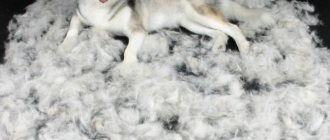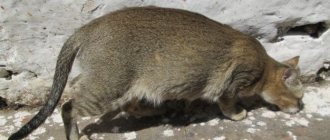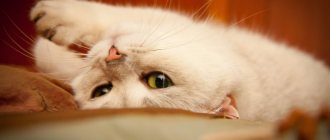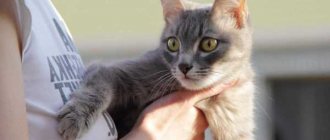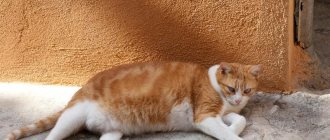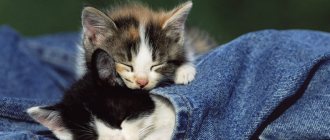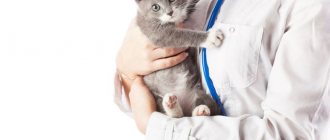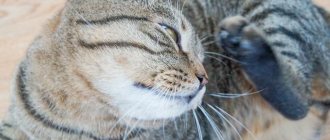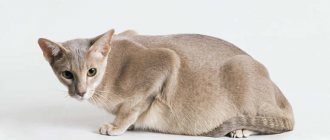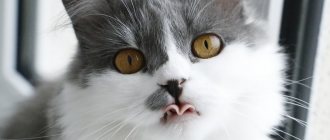Every owner of a domestic cat knows this unpleasant state: after removing a blissfully purring animal from your lap, you notice a layer of fur on your clothes, which takes a long time to clean off. And there’s no need to talk about the appearance of the plush chair chosen by the pet. The most annoying thing is that this problem is by no means limited to owners of long-haired breeds. All cats shed (with the exception of hairless sphinxes and left-handed cats). Yes, the problem of cat hair loss cannot be completely solved, but this does not mean that it should be ignored. Moreover, sometimes it is a signal: something is wrong with the cat.
Why and how cats shed
Shedding in cats is a natural, regular process of changing coat. Shedding in animals happens for different reasons and at different times.
Shedding is a common occurrence in cats.
Seasonal
In a normal situation, a cat sheds twice a year:
- the beginning of cold weather. The transition to the winter season is signaled by a decrease in daylight hours, a decrease in temperature, and this turns on protective mechanisms in animals. Cats quickly grow new fur to keep them warmer in cold weather.
- onset of heat. In summer, the hair grows lighter so that it does not get hot.
Cats who roam freely react the most to the change of season. Their body senses weather changes more strongly and reacts more sensitively.
Pets that are not allowed outside also shed, but regardless of natural conditions. Shedding occurs once or twice a year.
Seasonal molting lasts about a couple of weeks to two months. If the shedding continues, you should contact your veterinarian.
According to breed characteristics
In cats with long, thick fur, this process occurs much more noticeably.
Mustaches are divided into 4 types:
- long-haired;
- semi-longhaired;
- short-haired;
- hairless.
The shorter the coat and thinner the undercoat, the less problems with shedding.
Seasonal molting and its timing
Seasonal molting occurs twice a year: from February to March, the cat gradually prepares for summer, getting rid of winter fur, and from September to October, on the contrary, it strives to make room for a warm winter coat. The timing of shedding may vary depending on the breed of the cat, its climate zone, and the pet’s living conditions, but on average it lasts 2–3 weeks.
During shedding, a cat's behavior may change somewhat: it becomes less active, licks itself frequently, and some pets become irritable. But the general condition should not suffer: the nose should be cold, the eyes should be clean, the food should be eaten, and the tray should be visited as scheduled.
During normal shedding, the amount of fur a cat sheds increases, but does not become excessive . The replacement occurs evenly, without the formation of areas of focal alopecia (baldness).
During shedding, the cat often licks itself to remove dead hairs.
When do kittens start moulting?
Little kittens hardly shed; instead of fur they have baby fluff.
But caring for the fur of kittens should begin at a young age, as it will be much easier to accustom them to brushing.
However, caring for a kitten’s fur coat, and, in particular, brushing, must begin from an early age. It is much easier to train a small kitten to be groomed than an adult. Also, early brushing will help prepare them for their first shed.
It's easier to train a kitten to brush
Kittens begin to shed at about six months (5 – 8 months). Not only the fur changes, but also its color. When cats begin to shed for the first time, which can be up to 6 months, it is the most intense because the body is subject to a complex maturation process.
How to deal with shedding
Almost all cat owners ask this question. Some are sincerely concerned about the health of their ward, others are more concerned about the condition of the furniture and carpets.
Let's reveal a terrible secret: hair loss in cats cannot be cured.
Inaction is the best course of action
Above we have listed the six most likely causes of excessive shedding. Of these, only the last requires intervention, and only because hair loss in this case is an indicator of the presence of a disease that needs treatment. Moreover, there is no need to “help” a cat with seasonal or age-related (children’s) shedding; this process, even if it lasts for a whole year, does not cause any inconvenience to the animal.
Those who advise buying their pet vitamins “for the fur” are either their manufacturers (distributors) or naive victims of advertising.
If a cat receives a balanced diet, it does not need any additional vitamins.
As a rule, under this “sauce” we are offered drugs with unproven effectiveness, which, however, absolutely does not exclude side effects, including allergies.
Houseplant poisoning is not uncommon for cats.
If an animal sheds its fur, but still looks healthy and happy, it does not need treatment.
Causes of severe shedding
The normal state of health of an animal during molting is if:
- Skin of normal color.
- The wool does not fall out in clumps, leaving no bald spots.
- The cat has a normal appetite and a healthy appearance.
- There is no unpleasant odor from the mouth or ears.
- body temperature is normal.
Hair loss is almost never the only symptom of any disease.
But sometimes the shedding becomes very strong.
Apartment molt
This type of shedding is common in pets. It is especially aggravated during the heating season, when the air in the apartment becomes very dry. You can use a humidifier to avoid excessive hair loss.
Apartment shedding is stronger during the heating season
Hormones
Unneutered cats who are not sexually active may suffer from hormonal imbalances. This greatly affects the condition of the pet’s skin.
Hormones can fluctuate after estrus, during pregnancy and after childbirth, just like in humans.
If you do not breed cats, then it is better to have surgery. If this is not possible, your doctor may recommend a course to avoid hormonal imbalances.
Stress
Cats have a very good nervous system. But even they are susceptible to stress under certain conditions:
- Change of habitual habitat.
- A trip in public transport, a long road.
- The appearance of a new animal in the house.
- Long-term loneliness.
- Change of habitual way of life (usually lack of affection, new prohibitions, etc.)
Cats shed a lot due to stress
Try to save your cat from unnecessary worries and isolate him from unusual situations. If the shedding goes away, then the problem is definitely due to stress.
Improper care and feeding
Owners should take very good care of their beloved pets. Feeding and care are the main things we need to provide them with. Care products must be strictly individual and suitable for the cat’s breed (shampoos, brushes, ointments).
The diet must be balanced; you cannot feed cats food from the table. Good animal feed contains all the necessary microelements and substances.
Hair loss also occurs due to dysbiosis after treatment with antibiotics. Intestinal function is disrupted.
Old age
As cats age, their body begins to work worse, their immune system weakens, causing their fur to become thin, dull, and fall out. This is a natural life cycle.
Cats lose fur as they age
Allergy
An allergy is a skin reaction, namely inflammation, redness, itching. This ailment occurs as a result of a change in the usual diet.
Allergies are usually accompanied not just by hair loss, but by the formation of bald patches.
In case of allergies, hair falls out due to damage to the skin.
A possible allergen should be excluded and the process of hair loss should be monitored.
Diseases and parasites
Severe hair loss is caused by a number of diseases, both skin and internal. This is already a pathology.
Skin diseases:
- Ringworm, fungal infections.
- Demodicosis (subcutaneous mites);
- Dermatitis (due to flea secretions, ectoparasites).
- Scabies (Notoedris cati mite).
- Eczema.
In case of allergies, hair falls out due to damage to the skin.
All of these diseases are characterized by clear lesions and are accompanied by irritation and fur loss.
Internal diseases include endocrine system disorders, including diabetes mellitus or neoplasms. In these cases, baldness is a secondary symptom and the primary cause must be dealt with.
Features of shedding of some breeds
How a cat sheds is largely determined by its breed. The amount of hair left behind by a shedding cat is affected not only by the length of its coat (guard hair), but also by the density and length of the undercoat.
If we consider cat breeds according to the intensity of shedding, they can be divided into:
- highly shedding cats with a lot of undercoat: Persian and Himalayan cats;
- Maine Coon;
- British cat;
- Angora cat;
- Siamese cat;
- sphinxes - depending on the variety, hair may be completely absent or its length may be no more than 2 mm;
Shedding in sphinxes is minimal due to the almost complete absence of hair.
Ways to reduce shedding
It is impossible to get rid of natural shedding. Only serious illnesses require drastic interventions. And in normal times, we can only slightly reduce hair loss.
Vitamin complexes
Supplements reduce the amount of hair loss. Be sure to consult with your veterinarian about which vitamins are right for your pet.
Vitamins help against hair loss
Along with the supplements, you can give yolk (if you are not allergic) and sprouted grass.
Sprouted grass is useful in combination with vitamins
Buy a special paste for removing hairballs from the body of cats.
Special feed
A balanced diet is very important during such a period.
To ensure that the fur is always beautiful and healthy, and molting is not a severe torment, the animal’s food must contain: biotin (vitamin B7, deficiency leads to inflammation in the hair follicles. Acute biotin deficiency can lead to baldness) taurine, sulfur (enhances the effect of biotin ), vitamins B6, B2, B5, iodine, calcium, phosphorus, omega-3, omega-6.
Cat food is rich in essential nutrients
If the cat's diet consists of regular foods, then biotin and vitamin B6 must be present, which are found in beef, pork, chicken yolk, salmon, poultry, cheese, carrots, and buckwheat. But keep in mind that cats may be allergic to “human” food.
Dry food must be of high quality, at least super premium. They have everything you need to feed your pet.
There are two types of food recommended for consumption during shedding:
- Food for healthy skin and coat.
- Food for removing hair from the stomach.
Bathing and brushing
During washing and combing immediately after bathing, a very large amount of dead hair is removed.
More fur is combed after bathing
For cats with short fur, it is enough to brush them a couple of times a week with a regular comb. For fluffy, long-haired breeds, you will most likely have to take a Furminator. This is a professional device with very fine teeth.
Cats with long and thick hair are best combed with a furminator.
Proper cat hair care
Regular proper care of a cat's coat facilitates seasonal shedding and improves the condition of the coat . Care depends on the length of the cat's fur.
Short-haired cats are combed 1-2 times a week using a fine-toothed comb, a furminator to remove dead undercoat, and a rubber brush to remove combed hair and massage the skin, which improves blood supply to the hair follicles and strengthens the coat. You can use suede to add shine to the wool.
Long-haired cats are brushed daily for 15–20 minutes. To care for a long-haired cat you need:
- ridges: rare and frequent;
- a furminator with long teeth for removing undercoat or a slicker;
- metal brush;
- a soft brush to remove loose hair or a rubber brush.
The fur is combed from the tail to the head - this way you can get rid of more hairs. First use a comb with rare teeth, and then with frequent ones. After combing against the growth of the fur, the direction is changed. To remove undercoat, use a furminator or slicker - no more than once a week. At the end of combing, the separated wool is collected using a soft brush; you can use a rubber mitten brush. Some owners prefer to supplement grooming by stroking the cat with a damp hand to collect any remaining loose hair.
Constant proper grooming makes shedding easier
To make it easier to comb the coat, you can use a special powder. It is better not to use natural bristle brushes as they are not hygienic enough.
Cats are washed only when dirty or before shows. Frequent bathing can have a negative impact on their coat. When washing, use only zoo shampoos.
Video: how to brush a cat while shedding
Why is it important to remove dead hair?
Villi that have already fallen out but are not removed from the cat’s body can cause irritation and itching on the animal’s skin. It actively licks off excess fur and tries to remove it with its paws.
This can be dangerous because when hairballs get into the stomach, gastrointestinal upset and intestinal obstruction begin.
Hair getting into the stomach leads to intestinal disorders and causes nausea
With its paws, a cat can scratch itself, which serves as a breeding ground for infections that cause skin diseases.
Wool flying around the house can cause allergies in allergy sufferers living in the house, especially in the spring.
Kittens' first molt
Kittens have their first moult
is accompanied by the replacement of undyed hairs with the hair of adult animals and
occurs
, most often,
at the age of 5-7 months, in spring or autumn
. When purchasing kittens, you should understand that their color will likely change. Shedding starts from the head and gradually continues throughout the kitten's body. The animal's head will receive its permanent color before other parts of the body, and the rest of the body can molt for a whole year or even more.
Vitamins for cats
Cat owners have a choice: give imported complete food of premium class and higher or use natural food. In the first case, vitamins are not needed. They are included in the finished dry food in the required quantities and optimal ratio.
If the owner uses an unbalanced diet, the pet may develop problems with its coat. The problem is eliminated with the help of complex vitamin and mineral supplements.
Cat lovers prefer to use the following drugs:
- Felvit Multi;
- Kitty's +Taurine-Biotine;
- Gimpet Katzentabs;
- Laveta Super;
- Kitty's +Taurine-Biotine/Proteine/Cheese (vitamin mixture for cats);
- vitamins Doctor ZOO.
Treatment
Having made a diagnosis, the veterinarian prescribes treatment. It will be aimed at restoring the coat, as well as eliminating the cause of hair loss in the cat.
Treatment methods:
- If the problem of hair loss is associated with an allergic reaction of the cat to certain allergens, the animal must be completely protected from this allergen. After this, medications are prescribed to enhance immunity. If the allergy is caused by food, then it is necessary to put the cat on a hypoallergenic diet.
- For skin lesions caused by ectoparasites (ticks, fleas and lice), a veterinarian will prescribe special antiparasitic drugs (fleas in a cat). You will need to include vitamins and nutritional supplements in your diet to strengthen your cat’s immunity.
- If hair loss on the cat’s body appears as a result of an infectious disease, monovalent and associated vaccines against microsporia and trichophytosis are used - Mikkanis, Vakderm, Vakderm-F, Microderm, Polivak-, Pushnovak, etc.
When treating ringworm, veterinary specialists also use medications such as: Ketoconazole, Itraconazole, Griseofulfin, and so on. In this case, it is recommended to use immunosupportive agents and medications to improve metabolism. It is important to remember that ringworm is transmitted to humans.
- Hair loss caused by stress in cats is treated with special calming medications.
- Treatment of hair loss caused by subcutaneous parasites is described in our articles - demodicosis in cats, otodectosis in cats, notoedrosis.
- For endocrine disorders in a cat's body, hormonal medications are prescribed.
